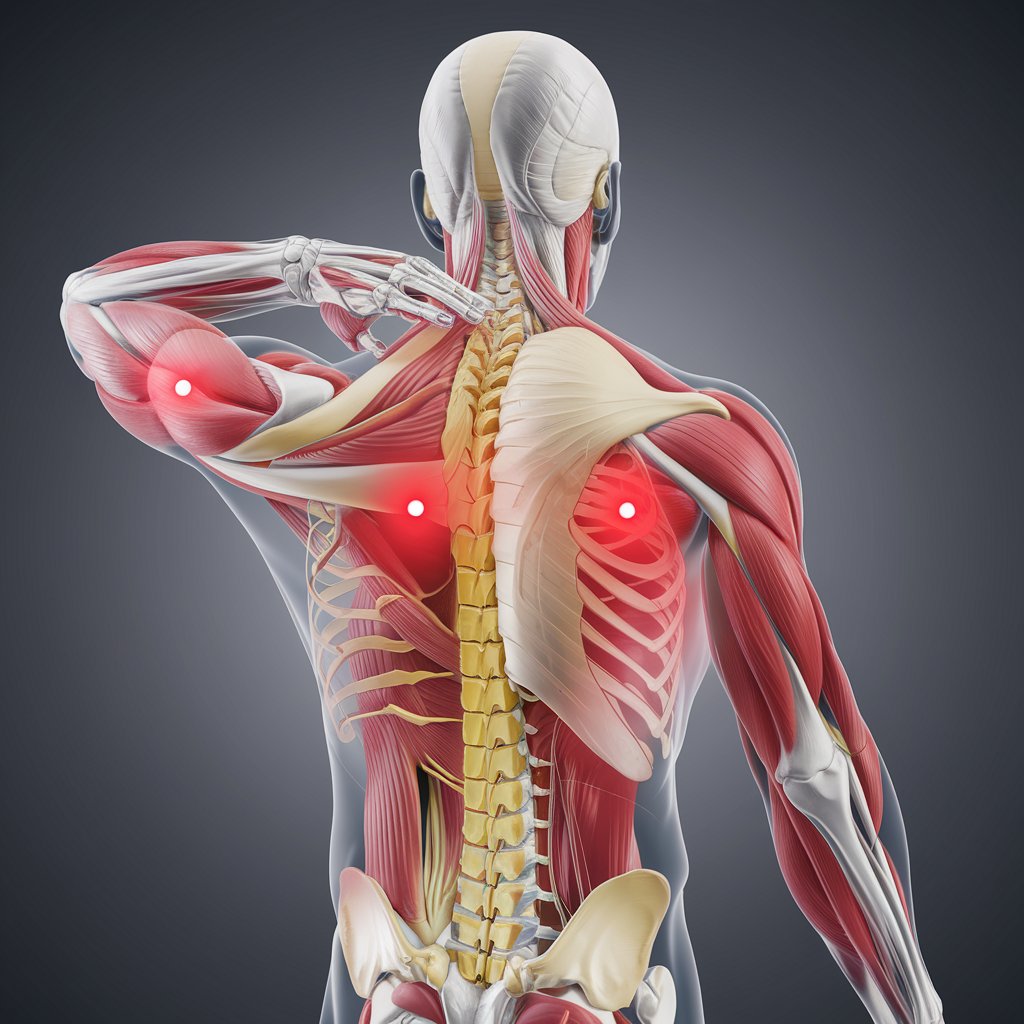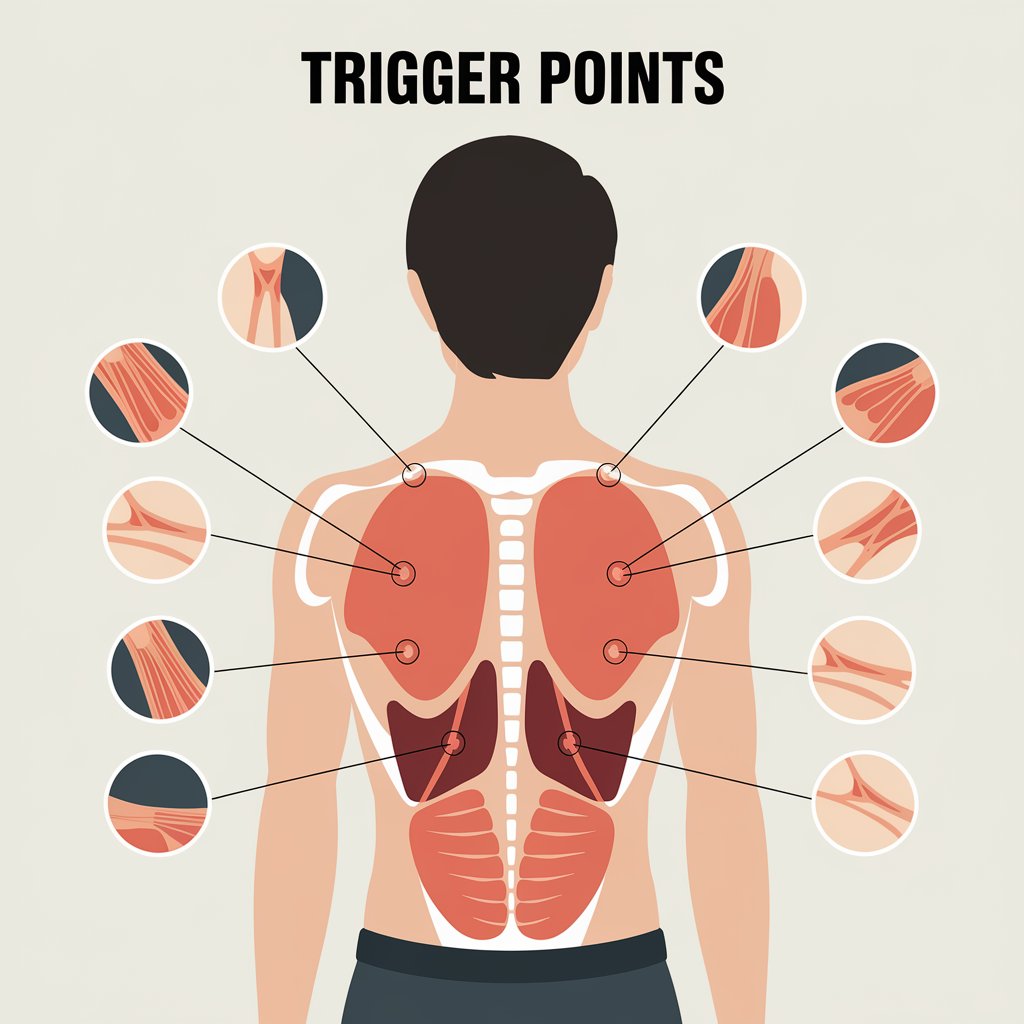Trigger points are painful spots in muscles that limit movement. Are you curious about their causes and treatments? This article covers symptoms and effective remedies for trigger points, helping you find relief.
Understanding Trigger Points
When you have muscle knots, also known as trigger points, you’ll feel pain and weakness in specific hyperirritable spots within your skeletal muscles. You might notice these areas as tight bands within your muscles that limit your range of motion and make it difficult for you to perform even basic tasks. Unlike the widespread muscle cramps you might experience that affect your entire muscle, trigger points only impact a small segment of your muscle tissue.
These notorious knots cause persistent and intense pain that can disrupt daily life activities. Once activated, they may interfere with normal movement and provoke discomfort at their location and in distant parts of your body (referred pain). Understanding trigger points and their mechanism is beneficial in seeking solutions for this prevalent problem.
Definition and Characteristics
According to Drs. Janet Travell and David Simons (1992), the definition of a trigger point is “a highly irritable localized spot of exquisite tenderness in a nodule in a palpable taut band of (skeletal) muscle.”The hyperirritable locations are situated in a tight strand of muscle fibers and can be detected as distinct, tender areas through palpation.
Trigger points that cause persistent and worsening pain can develop into a chronic condition known as myofascial pain syndrome, contributing to both musculoskeletal and mechanical muscular pain.
Research has shown that a high prevalence of trigger points is associated with:
-
myofascial pain -
psychological disturbance -
somatic dysfunction
Types of Trigger Points
Trigger Points can be divided into several groups:
1. Active Trigger Points
Active trigger points are well-known for their ability to provoke pain even when the affected muscle is not moving. These specific spots can generate intense, sharp discomfort directly at their location and send pain to distant body regions.
2. Inactive or Latent Trigger Points
Alternatively, latent trigger points may not induce pain spontaneously but can limit one’s range of motion and lead to muscle stiffness. It has been suggested that these points are more common in those who live a sedentary lifestyle. Pain from these points only becomes apparent when direct pressure is applied, rendering them less obvious than active trigger points.
3. Central Trigger Points
These are the most well-established trigger points when they are active. Also known as primary trigger points, they are located at the center of the muscle belly, where the MEP enters the muscle.
Causes of Trigger Points
Usually, TrPs develop as a result of:
-
Vitamin Deficiency - B1, B6, B12, C, folic acid, and iron -
Chronic Stress Condition -
Stress and Anxiety -
Sleep Problems -
Muscle Injury -
Bad Posture
Symptoms of Trigger Points
Trigger points can produce a wide array of symptoms, most notably acute and chronic pain that is felt directly at the trigger point or as referred pain in different parts of the body.
For example, a trigger point situated in your shoulder might lead to discomfort extending down your arm or up into your neck. Due to similar pain patterns, trigger points are often confused with other ailments like pinched nerves or migraines.
Muscle tension and a decrease in range of motion are also prevalent indications associated with trigger points. The application of pressure on such areas may result not only in severe localized pain but also provoke an involuntary “jump sign,” where you may react to the stimulation. This phenomenon typically occurs alongside a local twitch response, an observable or palpable contraction within the muscle.
Maintaining Trigger Point Factors
The presence of one or more of the following factors presents challenges in the prevention and treatment of trigger points over the long term:
-
Aging -
Obesity -
Anorexia -
Stress patterns -
Chronicity of trigger point -
Psychological factors (anxiety, depression, anger) -
Posture
Common Locations of Trigger Points
1. Neck and Shoulders
You may frequently develop trigger points in your neck and shoulder areas, especially within the trapezius muscle. These muscle knots can cause tension headaches and significant discomfort in the neck and shoulders. When you engage in repetitive movements or maintain poor posture, you’re more likely to experience the formation of these trigger points.
Massage therapy and similar techniques can effectively reduce muscle tension and provide relief by working on the affected areas.
2. Lower Back
You could experience trigger points in your lower back, specifically within the Quadratus Lumborum and Iliopsoas muscles; these muscles are common culprits of chronic pain and musculoskeletal issues. Such areas can cause severe distress, potentially hindering your ability to perform everyday tasks.
The pain from trigger points in your lower back can radiate throughout various body regions. As a result, specialized interventions like physical therapy and musculoskeletal rehabilitation become essential in addressing your referred pain.
3. Other Frequent Areas
You may develop trigger points in your gluteal muscles that can cause pain extending down your legs, often mimicking sciatica symptoms. Similarly, trigger points within your temporomandibular joint can induce jaw discomfort and headaches, which might be mistakenly attributed to dental issues. Recognizing and addressing these areas promptly is crucial for preventing the development of chronic pain conditions.
The presence of trigger points in both your gluteal region and temporomandibular joint can significantly impede your mobility and diminish your quality of life due to the intense pain experienced in these areas.
Prevention Strategies for Trigger Points
1. Stretching
Proper stretching helps prevent muscle imbalances that can lead to the formation of trigger points. Follow these simple steps to stretch effectively and maintain muscle health.
-
Warm Up First -
Stretch Slowly and Gently
-
Maintain Good Posture -
Don’t Bounce -
Breathe Deeply -
Stay Consistent
2. Strengthening
Not using your muscles regularly or staying inactive for long periods leads to muscle weakness. When muscles are weak, they struggle to support your body and handle daily activities, making them more likely to get strained or injured. This muscle weakness often plays a role in trigger point formation.
Choose to incorporate strengthening exercises and combine strength training, flexibility, and recovery techniques. Prioritize stability and balance, include a yoga-based stretching routine, and enhance recovery strategies to support overall muscle health.
3. Other Preventing Strategies for Trigger Point Formation
-
Stay Hydrated -
Regular quality sleep -
Meditation -
Deep breathing exercises -
Diet (anti-inflammatory nutrients)
Treatment Options for Trigger Points
1. Massage Therapy
Your body’s trigger points can be effectively managed through several treatment approaches. During massage therapy sessions, you might feel some initial discomfort, but many patients notice a significant improvement in both pain and muscle function by the next day.
Types of massage recommended:
-
Hot Stone Massage -
Deep Tissue Massage -
Swedish Massage -
Sports Massage -
Foam Rolling
2. Spray-and-Stretch
The spray-and-stretch method stands out as an effective treatment modality. It involves a cooling sensation as the spray is applied to the affected muscles, followed by gentle stretching. Many patients find this combination particularly effective at helping their muscles relax and reducing their pain.
Working with your physical therapist, you’ll discover which treatment methods work best for your specific needs. Since every patient responds differently to treatment, your therapist will help customize an approach that brings you the most relief.
3. Trigger Point Injections
Trigger point injections are an effective method for addressing trigger points. The main objective is to deactivate the trigger point and alleviate pain. A healthcare professional injects a small quantity of local anesthetic directly into the target area during treatment. This can aid in relaxing the affected muscle and diminish discomfort. Incorporating trigger point therapy may enhance this form of treatment.
4. Home Remedies
Managing trigger point pain can be effectively supported by home remedies such as the following:
-
Take warm baths to reduce muscle stress and tension -
Apply heat to the muscles to alleviate chronic pain -
Employ self-massage techniques with different instruments and introduce stretching in your routine in order to reduce stiffness
Frequently Asked Q’s
What causes trigger points to develop?
Trigger points can form due to various factors, including muscle overuse, poor posture, stress, vitamin deficiencies (B1, B6, B12, C, folic acid, and iron), sleep disturbances, and injuries. Chronic tension and prolonged inactivity can also contribute to their development.
How do I know if I have trigger points?
You may have trigger points if you experience persistent muscle pain, tight knots, tenderness, and a reduced range of motion. Referred pain, where discomfort spreads to distant areas, and a local twitch response when pressure is applied to the muscle are also common indicators.
What are the best treatments for trigger points?
Effective treatments include massage therapy (such as deep tissue and hot stone massage), foam rolling, physical therapy, stretching, strengthening exercises, trigger point injections, and home remedies like heat therapy and self-massage.
Can trigger points be prevented?
Yes, trigger points can be prevented through regular stretching, strengthening exercises, proper hydration, quality sleep, stress management techniques like meditation and deep breathing, and maintaining good posture throughout daily activities.






